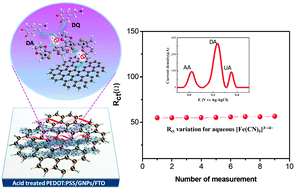Highly stable and conductive PEDOT:PSS/graphene nanocomposites for biosensor applications in aqueous medium†
Abstract
In this article, we demonstrated the development of highly water-stable and conductive poly(3,4-ethylenedioxythiophene):poly(styrene sulfonate) (PEDOT:PSS)/graphene nanoplatelet (GNP) [PPG] composites on a fluorine-doped tin oxide (FTO) electrode for the detection of dopamine (DA) in the presence of ascorbic acid (AA) and uric acid (UA) in aqueous medium. PPG was deposited on FTO via the electrospray technique from a mixture solution of PEDOT:PSS and GNPs, which was subsequently treated with sulfuric acid (H2SO4, 98%). Acid treatment enabled stabilisation of the GNPs on FTO in water, due to the removal of insulating and hydrophilic PSS (68%) from the composites, and concurrently increased the conductivity (105 S cm−1), owing to the presence of a high percentage of hydrophobic and conductive PEDOT, as well as strong π–π interactions between PEDOT and GNPs. The untreated PPG electrode exhibited low water stability of GNPs and low conductivity (23 S cm−1). Accordingly, the acid-treated PPG/FTO electrode showed very high electrochemical stability, low charge transfer resistance (Rct) at the electrode∣electrolyte interface, and improved catalytic activity for the oxidation of DA in aqueous buffer solution with very high sensitivity. It showed sufficiently high anodic peak-to-peak potential separations (ΔEpa) between DA and AA (0.27 V) and DA and UA (0.11 V) for the interference-free detection of DA with a detection limit (S/N = 3) and sensitivity of ∼105 nM and 27.7 μA μM−1 cm−2, respectively.



 Please wait while we load your content...
Please wait while we load your content...